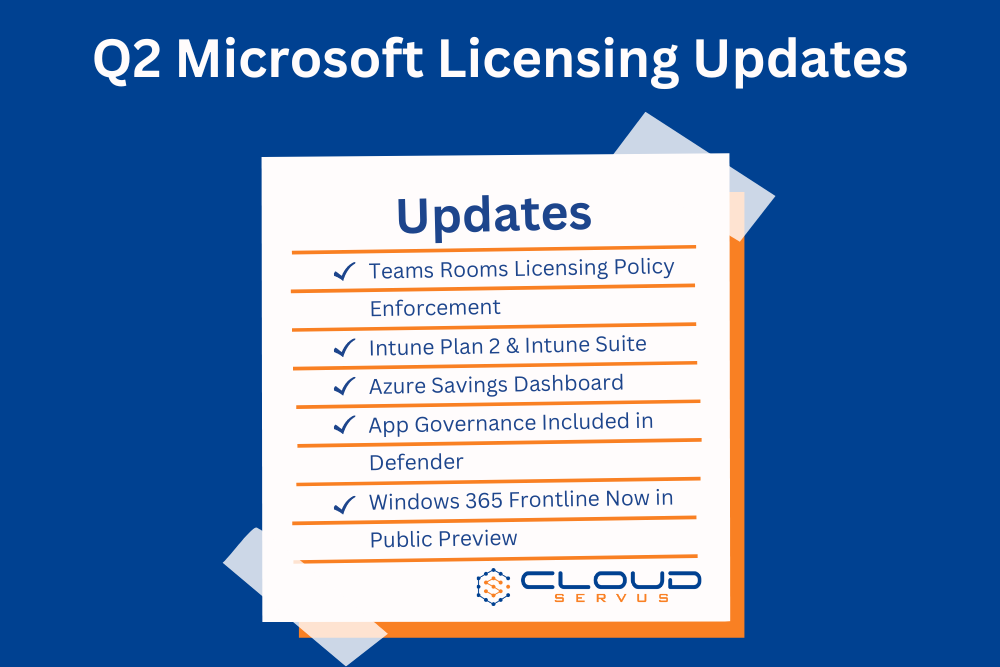Recent Microsoft Licensing Changes – Q4 2022
Microsoft Has Recently Announced Some Major Changes Microsoft licensing is complex and it’s often difficult to remain up to date on the constant...
4 min read
Dave Rowe Aug 29, 2024 10:55:43 AM

Microsoft announced earlier this year that Windows Server 2025 is available now in public preview and will be generally available later in 2024, so we want to provide a refresher on the licensing options for Windows Server. In October 2022, Microsoft made a significant change to Windows Server licensing. They added an additional licensing option for Windows Server for customers with active Software Assurance (SA) or Server Subscriptions. Rather than being restricted to licensing the whole physical server, these customers would now be able to choose to license at the virtual machine level. Let’s review this new licensing option as well as the other option, which is to license at the physical server level.
Whether you are using Hyper-V or VMware to virtualize, the Windows Server licensing requirements are the same. In this licensing model licenses are assigned to the server based on physical cores. This is subject to a minimum of 8 core licenses per processor and 16 core licenses per server. Standard edition allows use of Windows Server in the physical OSE, in addition to 2 virtual machines, as long as the physical OSE is used solely to host and manage virtual machines.
One thing I want to point out about licensing a VM cluster with Windows Server Standard is since there is no License Mobility rights with Windows Server (not even when you have active SA), you need to license each of the servers in the cluster for the highest number of virtual machines that can reside on a server at one time. Datacenter allows use of Windows Server in the physical OSE as well as an unlimited number of virtual machines on each fully licensed server. This licensing model does not require customers to maintain active Software Assurance on their Windows Server licenses. Let’s walk through a couple of scenarios to help you understand this licensing model and when these different editions make sense.
Scenario 1: Your organization has a VMware cluster that includes 3 Intel(R) Xeon(R) CPU E5-2650 v2 @ 2.60GHz servers which have 16 physical cores per server. There are 2 VMs assigned to each server in the highly available VM cluster so at any one time the VMs could seamlessly transfer to another server. This means that each of these servers could have up to 6 VMs running on it. From a licensing perspective, the organization would be required to license each of these servers for up to 6 VMs. Since Windows Server Standard covers 2 VMs each time all the physical cores are licensed your organization would need to license each server of the 3 servers for 48 cores (16 cores per server x 3 to cover the 6 VMs), for a total of 144 core licenses.
Scenario 2: Your organization has a VMware cluster that includes 4 Intel(R) Xeon(R) CPU E5-2650 v2 @ 2.60GHz servers which have 16 physical cores per server. There is a total of 45 VMs in this highly available VM cluster. Based on the high number of VMs in the cluster, we would recommend your organization consider licensing with Windows Server Datacenter which would provide you rights to unlimited virtualization. Your organization would need to license all the physical cores on the servers. This would mean that you would need 64 core licenses (16 cores per server x 4 servers).
This is a licensing option that became available in October 2022. Based on many conversations we have had with our customers regarding their Windows Server environments, we have concluded that most organizations are not familiar with this new way of licensing Windows Server, so let’s go through how this licensing model works.
This licensing model permits use in virtual machines only, meaning that there is no option to use Windows Server in the physical OSE. If your organization still needs to license the physical OSE in addition to the virtual machines, you could first license the physical servers for Windows Server based on physical cores, and additionally you would license the virtual machines separately. If you have fully licensed a server for Windows Server Datacenter based on physical cores, you already have the right to license any number of virtual machines.
Licensing by virtual machine requires licenses for all the virtual cores in the virtual machine subject to a minimum of 8 core licenses per virtual machine. This rule applies whether you are licensing the virtual machine with Windows Server Standard or Windows Server Datacenter. Additionally, licensing by virtual machine requires active Software Assurance or a subscription license. This means that if you currently own Windows Server licenses with no Software Assurance or you have let the Software Assurance expire, your organization is not allowed to apply those licenses to the individual virtual machines. And lastly, containers running on Hyper-V are considered separate VMs due to Hyper-V isolation and are subject to the same rules.
A Client Access License (CAL) is a license that gives a user or device the right to access the services of the server, whether the server is being accessed directly or indirectly through another application (per the rules of multiplexing). Licensing CALs per User usually makes more sense if your company's employees are accessing Windows Server from multiple devices, such as from their laptop and mobile phone. Device-based CALs are often more cost-effective if your organization has employees who share devices across different shifts.
The good news is there are online licenses that cover the rights to Windows Server CALs. Enterprise Mobility + Security E3 can be purchased stand-alone or as part of Microsoft 365 E3, E5, F1, or F3 cover Windows Server User CAL rights. So, any user that is licensed for one of these plans is covered with a Windows Server CAL. Enterprise Mobility + Security included in Microsoft 365 Business Premium unfortunately does not cover Windows Server CAL rights. One other thing I want to cover is CAL requirements for External Users. Microsoft recently updated the definition of External Users. As of October 2024, Microsoft will define External Users as “not (a) employees of Customer or its Affiliates, (b) contractors or agents that typically work for Customer or its Affiliates for more than 30 hours on average per week, or (c) contractors or agents that typically work onsite for Customer or its Affiliates on each working day”. If you have External Users that fit this definition you have several options:
Option 1: Acquire Windows Server CALs – either per User or Device for these External Users.
Option 2: Acquire and assign one of the above-mentioned online licenses that include Windows Server User CAL rights to the External Users.
Option 3: Acquire External Connector licenses for each server that will be accessed by your External Users. There is no limit to the number of External Users these licenses cover.
There are still more topics related to Windows Server that we have not discussed above, such as additional Software Assurance benefits, how Windows Server licenses can be applied to Azure VMs, and the various licensing programs your organization can purchase Windows Server on. These are topics we would be happy to discuss with you. Microsoft licensing is complicated, but you don’t have to navigate understanding it alone! As a trusted partner, CloudServus has Microsoft licensing experts on hand that have decades of experience working with organizations of all sizes. With CloudServus as your partner, you will be confident that you are licensing your Windows Server environment in the correct and most cost-effective way possible. Contact us today to get started or follow us on LinkedIn!

Microsoft Has Recently Announced Some Major Changes Microsoft licensing is complex and it’s often difficult to remain up to date on the constant...

Microsoft regularly rolls out new products and licensing updates, and at CloudServus, we’re here to help you stay ahead. From newly released products...

CloudServus aims to ensure that you stay informed about the dynamic landscape of Microsoft products and licensing. Our objective is to keep you...